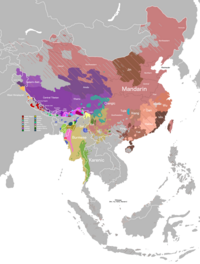Digaro languages
| Digarish | |
|---|---|
| Northern Mishmic | |
| Geographic distribution | Arunachal Pradesh |
| Linguistic classification | possibly Sino-Tibetan or an independent family
|
| Subdivisions | |
| Language codes | |
| ISO 639-3 | – |
| Glottolog | mish1241 |
The Digaro (Digarish), Northern Mishmi (Mishmic), or Kera'a–Tawrã[1] languages are a possible small family of possibly Sino-Tibetan languages spoken by the Mishmi people of southeastern Tibet and Arunachal Pradesh.
The languages are Idu and Taraon (Digaro, Darang). Lexical similarities are restricted to centain semantic fields, so a relationship between them is doubtful.[2]
External relationships
[edit]They are not related to the Southern Mishmi Midzu languages, apart from possibly being Sino-Tibetan. However, Blench and Post (2011) suggests that they may not even be Sino-Tibetan, but rather an independent language family of their own.
Blench (2014) classifies the Digaro languages as part of the Greater Siangic group of languages.
Names
[edit]Autonyms and exonyms for Digaro-speaking peoples, as well as Miju (Kaman), are given below (Jiang, et al. 2013:2-3).
| Taraon name | Kaman name | Idu name | Assamese name | |
|---|---|---|---|---|
| Taraon people | da31 raŋ53 | tɕi31 moŋ35 | tɑ31 rɑŋ35 | Digaru; Digaru Mishmi |
| Kaman people | tɕɑu53 | kɯ31 mɑn35 | mi31 tɕu55 | Midzu |
| Idu people | dju55; dju55 ta31 rɑŋ53; dɑi53 |
min31 dɑu55; hu53 |
i53 du55 | Chulikata Mishmi |
| Zha people 扎人 | tɕɑ31 kʰen55 | tɕɑ31 kreŋ35 | — | — |
| Tibetan people | lɑ31 mɑ55; mei53 bom55 |
dɯ31 luŋ35; hɑi35 hɯl55 |
ɑ31 mi53; pu53; mi31 si55 pu53 |
— |
Registers
[edit]Idu, Tawra, Kman, and Meyor all share a system of multiple language registers, which are (Blench 2016):[3]
- ordinary speech
- speech of hunters: lexical substitution, the replacement of animal names and others by special lexical forms, and sometimes short poems
- speech of priests/shamans: more complex, involving much language which is difficult to understand, and also lengthy descriptions of sacrificial animals
- poetic/lyrical register (not in Idu, but appears in Kman)
- mediation register (only in Idu?)
- babytalk register
References
[edit]- ^ DeLancey, Scott (2021). "Classifying Trans-Himalayan (Sino-Tibetan) languages". The Languages and Linguistics of Mainland Southeast Asia. De Gruyter. pp. 207–224. doi:10.1515/9783110558142-012. ISBN 9783110558142. S2CID 238722139.
- ^ Blench, R.M. 2024. The ‘Mishmi’ languages, Idu, Tawrã and Kman: a mismatch between cultural and linguistic relations. In: Movements through Time and Space: Ecology and Lingua-Cultural Change in South and Southeast Asia. Nishant Choksi ed. Guwahati: Pragjyotish Centre for Cultural Research.
- ^ Blench, Roger. "(PDF) Mishmi language development | Roger Blench - Academia.edu".
- Blench, Roger (2011) (De)classifying Arunachal languages: Reconstructing the evidence
- Blench, Roger (2014). Fallen leaves blow away: a neo-Hammarstromian approach to Sino-Tibetan classification. Presentation given at the University of New England, Armidale, 6 September 2014.
- Blench, Roger. 2017. The ‘Mishmi’ languages, Idu, Tawra and Kman: a mismatch between cultural and linguistic relations.
- Jiang Huo [江获], Li Daqin [李大勤], Sun Hongkai [孙宏开] (2013). A study of Taraon [达让语研]. Beijing: Ethnic Publishing House [民族出版社]. ISBN 9787105129324
- van Driem, George (2001) Languages of the Himalayas: An Ethnolinguistic Handbook of the Greater Himalayan Region. Brill.

